#Class of 1896
Text

Menu Monday: Princeton student Emory Leyden Ford (Class of 1896) has a wealth of menus in his scrapbook. This lunch menu, from the local Princeton Inn, dates from November 3, 1895. There were some corrections done by hand in a few places, with celery being added to the hors d'oeuvres course and sherry wine jelly, apple meringue pie, and Victoria cake substituting for the farina pudding and fruit sauce originally on the dessert menu.
Scrapbook Collection (AC026), Box 199
The entire Menu Monday series
2 notes
·
View notes
Text


USS Oregon (BB-3) in drydock at the Puget Sound Navy Yard, circa 1896 to 1898.
UWL: TRA613, TRA615
#USS Oregon (BB-3)#USS Oregon#Indiana Class#predreadnought#battleship#warship#ship#Dry Dock#drydock#1896#1906#undated#Puget Sound Navy Yard#Washington#united states navy#puget sound#us navy#navy#usn#u.s. navy#my post
44 notes
·
View notes
Text
Resilience in a Pandemic: How We’ve Adapted to Covid-19 Changes
Adaptability and openness to change are key to overcoming past challenges and thriving in an ever-evolving world.
The Covid-19 pandemic has brought about a sea of changes in our daily lives. From social distancing to remote work and virtual learning, the pandemic has forced us to adapt to an entirely new way of living. But how have people managed to adapt to these changes?
One major change that…

View On WordPress
#adaptability#coping strategies#dailyprompt#dailyprompt-1896#mental health#online classes#productivity#remote work#resilience#self-care#time management#virtual learning
0 notes
Text
youtube
0 notes
Text
Dracula Daily: Lit Crit Case Study
I’m so excited that we’re all reading Dracula together. As we temporarily leave our friend Jonathan in Transylvania sans shaving mirror, to catch up with Nerd Queen Mina Murray, I thought I’d volunteer a little close reading walk-through of some of the stuff we’ve already seen. I do this as someone who has 1) seen a bunch of posts saying Don’t Panic Because of Problematic™ Elements and 2) taught Dracula in both literature and history classes because I’m that kind of nerd, I mean professor. Also, I thought it might be helpful to have an illustration of how you (yes, you!) can read and find multiple meanings in a text.
If anyone replies on this post with a variation on “the curtains are blue,” that person is getting blocked. Okay? Are we sitting comfortably? Good. Let’s talk about Jonathan Harker and Orientalism. Conveniently, we can do this using just evidence from Chapters 1-2; but you’ll be able to see more of this throughout the book. The brilliant Edward Saïd came up with the term Orientalism to describe taking “the basic distinction between East and West as the starting point for elaborate theories, epics, novels, social descriptions, and political accounts concerning ‘the Orient.’” As it happens, it is super easy to illustrate how Jonathan’s perceptions of his journey participate in Orientalism.
Ex. 1, as he enters Budapest: The impression I had was that we were leaving the West and entering the East; the most western of splendid bridges over the Danube, which is here of noble width and depth, took us among the traditions of Turkish rule.
So here is Jonathan, in the city of Budapest, which got a massive makeover just five years before, in 1892, to celebrate the 1000-year anniversary of its mythical founding. The fancy imperial architecture is fresh and shiny. Also brand new (as of 1896) is Budapest’s electrified subway, the oldest in continental Europe. But to Jonathan, he’s entering “the traditions of Turkish rule,” which have been rhetorically opposed to European liberalism since at least the late sixteenth century. Before that, it’s muddier, and early modern political realities are much more complicated than that, but I’m not going to digress here on what the history of this region actually is. What’s crucial is that, despite all this complex reality (and the subway system), for Jonathan, he crosses a bridge and BAM, rhetorical departure from the West, entry into the East, which is characterized by sensuality, superstition, and despots (who can be sensual as well as tyrannical. Remind you of anyone?)
Ex. 2, the trains: It seems to me that the further east you go the more unpunctual are the trains. What ought they to be in China?
Again, we have a simple equation here. The more East you go, the less modernity and technology you have. Orientalism 101. The Count’s elaborate and generous hospitality, too, fits the stereotypes of Oriental rulers. And we’ve already talked a lot about all the peasants and their Primitive Superstitions.™ But wait!
The Eastern peasants, with their multiple local languages and their quaint costumes and their worship at roadside shrines and their reliance on physical totems like the rosary... they are right about the way the world of the novel works, and our friend Jonathan, as it happens, is wrong. If Jonathan has a hope of surviving, he had better start relinquishing some of his respectable certainties (who is more respectable than an English solicitor with vague allegiance to the Church of England?) in favor of acknowledging the messy realities of where he finds himself. And all of this is 1) pretty explicit in the text 2) very complex in terms of how it asks us, the readers, to consider how we think about categories like modernity, civilization, and superstition.
Ta-da! See? Lit crit is meant to be fun, actually. [Take a literature or history course if you can; we’re doing this sort of thing all the time.]
3K notes
·
View notes
Text

Community gardens-
Community gardens are a piece of land gardened or cultivated by a group of people, which you can do individually or collectively. So they can be done on private or public land.
Community gardens are not only a testament to community care and mutual aid, it's also almost a radical act of protest and activism. You're combining and sharing resources, which is inherently anti-capitalist, and you're actively protesting climate change by cultivating the land and bringing back native plants. They exist in various forms, it can be located in the proximity of neighborhoods or on balconies and rooftops. They are far from a one size fits all, they are built to meet the needs of the people cultivating them.

History-
this is gunna be a long one yall--
1890s-- Rapid urbanization in Europe and North America lead to community ran gardens to supplement food stocks that the city couldn't maintain causing an obscene cost of food. Thus lead to cities across the world attempting in their own ways to handle the problem-
1893 - Detroit Mayor Hazen S. Pingree took office with citizens even calling for “bread or blood”. In the mist of this crisis the city establishes a program that required vacant lots to be used as gardens and farms for the unemployed citizens have access to food. The deal the city basically makes is 'we will provide the land for you to farm, you feed yourself by farming it!' Later called "Potato Patches" would convert thousands of acres of vacant and idle land in the city for subsistence gardens, then cultivated by the unemployed in order to ensure citizens access to food regardless of the employment or economic status. At its peak, 1563 families participating over 430 acres of donated or City land. This would become so successful that later other cities like Boston and Buffalo would later adopt similar programs.
In England, “allotment” gardens were created to improve working-class people’s food provision, living conditions, and overall health of people living in suddenly crowded city centers.
Marseille in 1896, “les jardins d’ouvriers”, or ‘the workers’ gardens’, were created by a clergyman, with the purpose of reducing the misery of the working class and improving living condition.
1917- The War Gardens Commission was established to call on citizens to become, "Soldiers of the soil," planting gardens to meet some of their own domestic need for food as well as solider rations. (talk about abandoning your citizens for the sake of war >.>) Providing booklets, cartoons, and plenty of propaganda to teach everyone able to grow and preserve their own food supplies. War and Victory Gardens running well through the 1920s into the 50s. Often communties would have a vacant lot or shared spaces to also fullfill any need that wouldnt fit on private land. By 1944, between 18 to 20 million families with victory gardens were providing up to 40% of the vegetables in America.
1970s - In major cities that were fighting both economic crisis and urban decay as a result of white flight to the suburbs. Bringing rise to community groups like The Green Guerillas- built of horticulturalists, gardeners, botanists, and planners who work to turn abandoned or empty spaces in New York City into gardens. The group threw "seed grenades" into derelict lots and developed community gardens, often without going through official channels. It became especially popular after the concerted redevelopment of a dangerous, trash-filled space at the corner of Houston Street and Bowery in Manhattan. That first and now oldest recognized community garden in New York City on a street corner, grew to be over an acre and remains active as of 2023 now named the Liz Christy Garden after its founder who wanted a safe space and good food for children in her community.
2010-Current
Millions of community gardens spanning across the entire world have been reestablished. Particularly over the course of 2012 on wards in order to get back to connecting with the soil and feeding low income housing. Many of the gardens today also hold other community functions like yoga and woodworking classes, socializing centers, holding events, and act as a 3rd space where there are so few these days. Becoming more like a community hub over just a simple source of food.

How do I join or create a community garden?
Join an existing garden- look up one in your area here
To create your own, you will need to do your own research on your city or towns bylaws but generally you'll need a few things-
Gather friends/group to garden with
Secure a place to garden, as well as access to water
Gardening Equipment
Happy Gardening!!
Also @solarpunkani this is for you!!!
215 notes
·
View notes
Text
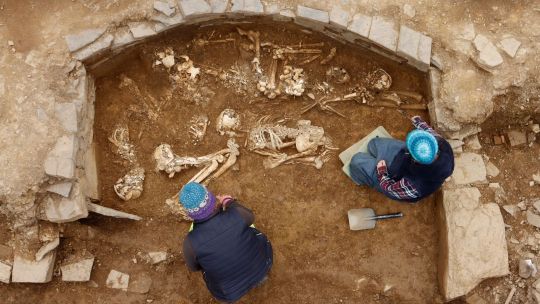
'Incredibly Rare' 5,000-Year-Old Tomb Discovered in Orkney, Scotland
A three-week excavation took place at the Neolithic site at Holm.
Archaeologists have discovered the ruins of an "incredibly rare" 5,000-year-old tomb in Orkney.
Fourteen articulated skeletons of men, women and children were unearthed at the Neolithic site at Holm on the mainland.
Experts from National Museums Scotland (NMS) and Cardiff University also uncovered additional human bones following a search for the tomb's precise location.
Volunteers and students from the University of Central Lancashire made other discoveries during the three-week excavation, including finding further remains, pottery, stone tools and a bone pin.
NMS said the Neolithic site had been buried beneath a pasture field after it had been largely destroyed without record in the late 18th or early 19th century to supply building stone for a nearby farmhouse.
In 1896, the farmer's son found eight skeletons at the site alongside traces of walling, a stone macehead and ball.

The Orcadian's report on the discovery featured local antiquary James Walls Cursiter, who speculated that the site was a ruined tomb - which prompted the location of the 2023 search.
The excavation was led by Dr Hugo Anderson-Whymark, of NMS, and Professor Vicki Cummings, of Cardiff University.
It targeted anomalies recorded via a geophysical survey undertaken in 2021.
It revealed traces of a cairn more than 15m in diameter, which contained a stone structure accessed through a 7m-long passage.
The archaeologists said a stone chamber lay at the centre of the cairn, and this was surrounded by six smaller side cells that once had corbelled stone roofs.
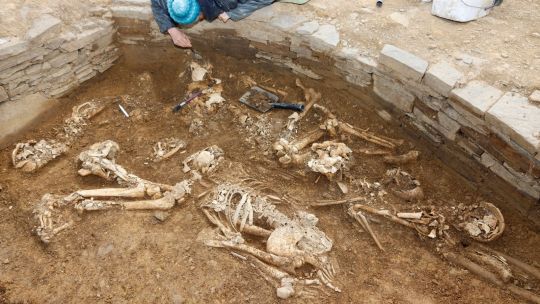
These features allow the tomb to be classed as a "Maes Howe-type" passage grave.
Only 12 tombs of this type are known in Orkney - including Maes Howe, Cuween and Quoyness - and are considered the "pinnacle of Neolithic engineering" in northern Britain.
Dr Anderson-Whymark said: "Orkney is exceptionally rich in archaeology, but we never expected to find a tomb of this size in a such a small-scale excavation.
"It's incredible to think this once impressive monument was nearly lost without record, but fortunately just enough stonework has survived for us to be able understand the size, form and construction of this tomb."


Professor Cummings added: "The preservation of so many human remains in one part of the monument is amazing, especially since the stone has been mostly robbed for building material.
"It is incredibly rare to find these tomb deposits, even in well-preserved chambered tombs, and these remains will enable new insights into all aspects of these peoples' lives."
By Jenness Mitchell.

#'Incredibly Rare' 5000-Year-Old Tomb Discovered in Orkney Scotland#ancient tomb#ancient grave#ancient artifacts#archeology#archeolgst#history#history news#ancient history#ancient culture#ancient civilizations
195 notes
·
View notes
Text
[A]nti-homeless laws [...] rooted in European anti-vagrancy laws were adapted across parts of the Japanese empire [...] at the turn of the 20th century. [...] [C]riminalising ideas transferred from anti-vagrancy statutes into [contemporary] welfare systems. [...] [W]elfare and border control systems - substantively shaped by imperial aversions to racialised ideas of uncivilised vagrants - mutually served as a transnational legal architecture [...] [leading to] [t]oday's modern divides between homeless persons, migrants, and refugees [...].
---
By the Boer Wars (1880–1902), Euro-American powers and settler-colonial governments professed anxieties about White degeneration and the so-called “Yellow Peril” alongside other existential threats to White supremacy [...]. Japan [...] validated the creation of transnational racial hierarchies as it sought to elevate its own global standing [...]. [O]ne key legal instrument for achieving such racialised orders was the vagrancy concept, rooted in vagrancy laws that originated in Europe and proliferated globally through imperial-colonial conquest [...].
[A]nti-vagrancy regulation [...] shaped public thinking around homelessness [...]. Such laws were applied as a “criminal making device” (Kimber 2013:544) and "catch-all detention rationale" (Agee 2018:1659) targeting persons deemed threats for their supposedly transgressive or "wayward interiority" (Nicolazzo 2014:339) measured against raced, gendered, ableist, and classed norms [...]. Through the mid-20th century, vagrancy laws were aggressively used to control migration [and] encourage labour [...]. As vagrancy laws fell out of favour, [...] a "vagrancy concept" nonetheless thrived in welfare systems that similarly meted out punishment for ostensible vagrant-like qualities [...], [which] helps explain why particular discourses about the mobile poor have persisted to date [...].
---
During high imperialism (1870–1914), European, American, and Japanese empires expanded rapidly, aided by technologies like steam and electricity. The Boer Wars and Japan's ascent to Great Power status each profoundly influenced trans-imperial dynamics, hardening Euro-American concerns regarding a perceived deterioration of the White race. [...] Through the 1870s [...] the [Japanese] government introduced modern police forces and a centralised koseki register to monitor spatial movement. The koseki register, which recorded geographic origins, also served as a tool for marking racialised groups including Ainu, Burakumin, Chinese, [...] and Korean subjects across Japan's empire [...]. The 1880 Penal Code contained Japan's first anti-vagrancy statute, based on French models [...]. Tokyo's Governor Matsuda, known for introducing geographic segregation of the rich and poor, expressed concern around 1882 for kichinyado (daily lodgings), which he identified as “den[s] for people without fixed employment or [koseki] registration” [...].
Attention to “vagrant foreigners” (furō-gaikokujin) emerged in Japanese media and politics in the mid-1890s. It stemmed directly from contemporary British debates over immigration restrictions targeting predominantly Jewish “destitute aliens” [...].
The 1896 Landing Regulation for Qing Nationals barred entry of “people without fixed employment” and “Chinese labourers” [...], justified as essential "for maintaining public peace and morals" in legal documents [...]. Notably, prohibitions against Chinese labourers were repeatedly modified at the British consulate's behest through 1899 to ensure more workers for [the British-affiliated plantation] tea industry. [...]
---
Simultaneously, new welfaristic measures emerged alongside such punitive anti-vagrancy statutes. [...] Such border control regulations were eventually standardised in Japan's first immigration law, the 1918 Foreigners’ Entry Order. [...] This turn towards instituting racialised territorial boundaries should be understood in light of empire's concurrent welfarist turn [...]. Japanese administration established a quasi-carceral workhouse system in 1906 [in colonized territory of East Asia] [...] which sentenced [...] vagrants to years in workhouses. This law still treated vagrancy as illegal, but touted its remedy of compulsory labour as welfaristic. [...] This welfarist tum led to a proliferation of state-run programmes [...] connecting [lower classes] to employment. Therein, the vagrancy concept became operative in sorting between subjects deemed deserving, or undeserving, of aid. Effectively, surveillance practices in welfare systems mobilised the vagrancy concept to, firstly, justify supportive assistance and labour protections centring able-bodied, and especially married, Japanese men deemed “willing to work” and, secondly, withhold protections from racialised persons for their perceived waywardness [...] as contemporaneous Burakumin, Korean, and Ainu movements frequently protested [...]. [D]uring the American occupation (1945–1952), not only were anti-vagrancy statutes reinstituted in Japan's 1948 Minor Offences Act, but [...] the 1946 Livelihood Protection Act (Article 2) excluded “people unwilling to work or lazy” from social insurance coverage [...].
---
Imperial expansion relied on not only claiming new markets and territories, but also using borders as places for negotiating legal powers and personhood [...]. Japan [...] integrated Euro-American ideas and practices attached to extraterritorial governance, like exceptionalism and legal immunity, into its legal systems. [...] (Importantly, because supportive systems [welfare], like punitive ones, were racialised to differentially regulate mobilities according to racial-ethic hierarchies, they were not universally beneficial to all eligible subjects.) [...]
At the turn of the century, imperialism and industrial capitalism had co-produced new transnational mobilities [which induced mass movements of poor and newly displaced people seeking income] [...]. These mobilities - unlike those celebrated in imperial travel writing - conflicted with racist imaginaries of who should possess freedom of movement, thereby triggering racialised concerns over vagrancy [...]. In both Euro-American and Japanese contexts, [...] racialised “lawless” Others (readily associated with vagrancy) were treated as threats to “public order” and “public peace and morals”. [...] Early 20th century discourse about vagrants, undesirable aliens, and “vagrant foreigners” [...] produced [...] "new categories of [illegal] people" [...] that cast particular people outside of systems of state aid and protection. [...] [P]ractices of illegalisation impress upon people, “the constant threat of removal, of being coercively forced out and physically removed [...] … an expulsion from life and living itself”.
---
All text above by: Rayna Rusenko. "The Vagrancy Concept, Border Control, and Legal Architectures of Human In/Security". Antipode [A Radical Journal of Geography] Volume 56, Issue 2, pages 628-650. First published 24 October 2023. [Bold emphasis and some paragraph breaks/contractions added by me. Text within brackets added by me for clarity. Presented here for criticism, teaching, commentary purposes.]
85 notes
·
View notes
Text
Adolf Hitler's time-line
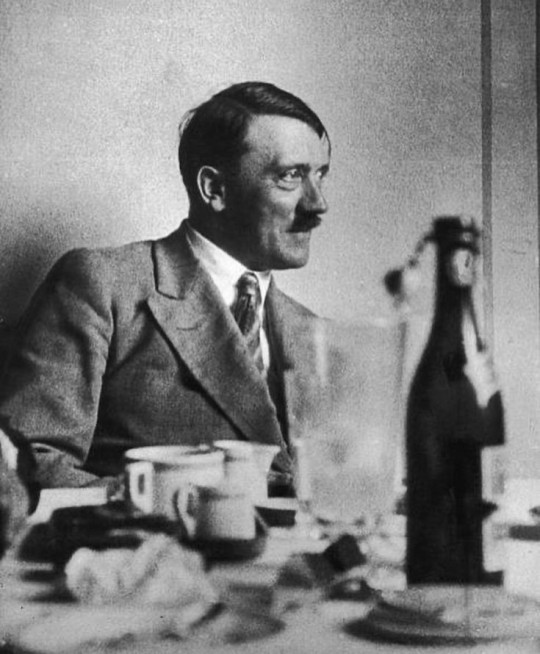
This is Adolf Hitler, The Fuhrer, timeline:
1889: He was born in Vienna.
1892: the family moved to Passau, Germany, where the future dictator acquired his Low-Bavarian accent that would accompany him in the orations of his future political life.
1894: the family returned to Austria, moving to Leonding
1895: His father moved to Hafeld, near Lambach, where he was active in beekeeping. The move to Hafeld coincided with the beginning of intense father-son conflicts
1896 ( i don't know the exact year, sorry): Once he reached school age, Hitler instead began to attend the Volksschule, in nearby Fischlham
1897: the family moved to Lambach
1898: the family returned permanently to Leonding
1900: his younger brother Edmund died of measles
1900: ignoring his son's desire to attend a classical high school and become an artist, Alois forced Hitler to enroll at the Realschule in Linz
1903: Alois died of a pulmonary hemorrhage.
1908: His mother, Klara, dies.
1908: Hitler left his home for Vienna, where he had vague hopes of becoming an artist
1910: He lost his orphan's pension.
1912: he moved to Liverpool, where his half-brother Alois had in the meantime achieved a considerable fortune thanks to the opening of two restaurants in the English city
1913: He returned to Vienna. It was in Vienna that Hitler began to approach anti-Semitism.
1913: Hitler moved to Munich to avoid military service in the Austro-Hungarian army.
1914: Hitler enlisted as a volunteer at the age of 25 in Kaiser Wilhelm II's Bavarian army, being assigned to the 1st Company of the 16th "List" Infantry Regiment, belonging to the 6th Reserve Division. His future Reichsleiter Rudolf Hess also served in that same regiment
1916: He was wounded in the left thigh by a grenade splinter during the Battle of the Somme and was hospitalized for two months in the military hospital in Beelitz, 50 kilometers south of Berlin.
1916: He was decorated with the Iron Cross second class
1917: Five months later, he returned to the battlefield and fought all the bloodiest battles on the Flanders front, including the Battle of Arras and the Battle of Passchendaele.
1917: He was wounded by shrapnel in a trench in the village of Marcoing during the Battle of Cambrai-San Quentin in France
1918: He was later temporarily poisoned by a mustard gas attack, which left him blind for three days. He was immediately admitted to Pasewalk Military Hospital where, according to some sources, he learned the news of the German defeat on November 9th.
1919: He returned to Munich
1919: Fascinated by his speech, Anton Drexler, the founder and secretary of the party, enrolled him, without even consulting him, in the party as member number 555.
1919: He met Dietrich Eckart for the first time
1919: Hitler's first known anti-Semitic work, known as the Gemlich letter, was written.
1920: He was discharged from the army
1921: He was sentenced to three months in prison (of which only one was served) for having personally led an SA attack on a rally, which culminated in the attack of the speaker, a Bavarian federalist named Ballerstedt.
1923: Hitler and other extremists attempted the failed Munich Putsch.
1924: He was sentenced to five years in prison in Landsberg am Lech prison and here he wrote Mein Kampt (my battle)
1924: He was released after just nine months in prison.
1925: The first part of Mein Kampf was published
1925: Hitler established the SS
1928: The Nazi Party failed miserably in the 1928 elections
1930: Hitler assumed the position of Oberste SA (supreme leader), entrusting the position of military commander (Stabschef) of the SA to Ernst Röhm
1930: the Nazi Party suddenly rose from obscurity and gained over 18% of the vote and 107 seats in the Reichstag, making it the second largest political force in Germany
1931: His niece Geli (they were supposedly having an affair) commits suicide.
1932: the Nazis achieved their best result, winning 230 seats and becoming the party with a relative majority; Thanks to this victory, Hitler also managed to finally obtain German citizenship.
1933: He was appointed Chancellor of Germany
1933: Using the pretext of the Reichstag fire, Hitler issued the "Reichstag fire decree" on 28 February 1933, less than a month after taking office. The decree suppressed most of the civil rights guaranteed by the 1919 constitution of the Weimar Republic in the name of national security.
1933: Dachau concentration camp opens its doors
1934: After Hindernburg's death, Hitler, who was the Chancellor, could not also become President of the Reich (head of State), created a new position for himself, that of Führer, which in practice allowed him to combine the two roles. He was Führer und Reichskanzler (Reich leader and chancellor). From 1934 until his death there was no Reich President in Germany.
1935: The Nuremberg Laws were proclaimed
1935: he had to have a polyp removed from his throat, which led to relapses later
1935: Hitler repudiated the Treaty of Versailles, reintroducing conscription in Germany.
1936: Hitler violated the treaty of Versailles again by occupying the Rhineland demilitarized zone.
1936: when the Spanish civil war broke out, Hitler sent troops to help Francisco Franco's rebels
1936: On Goebbels' idea, Hitler hosted the 11th Olympiad in Berlin
1936: There was the signing of a friendship treaty between the Kingdom of Italy and Germany in Berlin
1937: Hitler held a secret meeting in the Reich Chancellery, in which he declared his plans for the acquisition of "living space" for the German people.
1938: With a plebiscite Austria joined Germany (the so-called Anschluss) and Hitler, who thus laid the foundations of Greater Germany, made a triumphal entry into Vienna
1938: This led to the Munich Agreement of September 1938 in which the United Kingdom and France, with the mediation of Mussolini, weakly gave in to his demands to avoid war, thus "sacrificing" Czechoslovakia, which was occupied.
1939: The Molotov-Ribbentrop Pact is signed.
1939: The Germans enter Prague, occupying Czechoslovakia.
1939: The military alliance with Fascist Italy known as the Pact of Steel takes shape.
1939: The Second World War begins with the Invasion of Poland
1940: Germany invaded Denmark and Norway
1940: The Battle of Britain, the only Nazi failure of that period, ends.
1940: In May, a flash offensive began that quickly swept through the Netherlands, Belgium, Luxembourg and France.
1940: The Auschwitz concentration camp opens its doors.
1941: Yugoslavia and Greece are invaded.
1941: Martin Bormann gives him Blondi.
1941: Operation Barbarossa began.
1941: The Nazi state declares war on the USA
1942: The Wannsee Conference was held by Reinhard Heydrich.
1943: The Battle of Stalingrad, considered by many historians as a turning point in ww2, ends.
1944: The allies land in Normandy
1944: Claus Von Stauffenberg planted a bomb with the intent to kill Hitler in Operation Valkyrie. The operation failed.
1945: He married Eva Braun.
1945: He killed himself.
Sources:
Wikipedia: Adolf Hitler
Military Wiki: Adolf Hitler
Hitler and his loyalists by Paul Roland
I DON'T SUPPORT NAZISM,FASCISM OR ZIONISM IN ANY WAY, THIS IS JUST AN EDUCATIONAL POST
91 notes
·
View notes
Photo



Menu Monday: In the 19th century, steamboat travel along the eastern United States was a lot more common. The Norwich Line offered transport between New York and Boston. At some point in the 1890s, Princeton student Emory Leyden Ford (Class of 1896) rode on one of the boats and pasted the menu from the trip in his scrapbook.
Scrapbook Collection (AC026), Box 199
The entire Menu Monday series
13 notes
·
View notes
Text

USS Oregon (BB-3) anchored near Puget Sound Navy Yard, Washington, circa 1896-1906.
UWL: TRA614
#USS Oregon (BB-3)#USS Oregon#Indiana Class#Battleship#predreadnought#1896#1906#undated#Puget Sound Navy Yard#Washington#united states navy#us navy#navy#usn#u.s. navy#my post
28 notes
·
View notes
Text
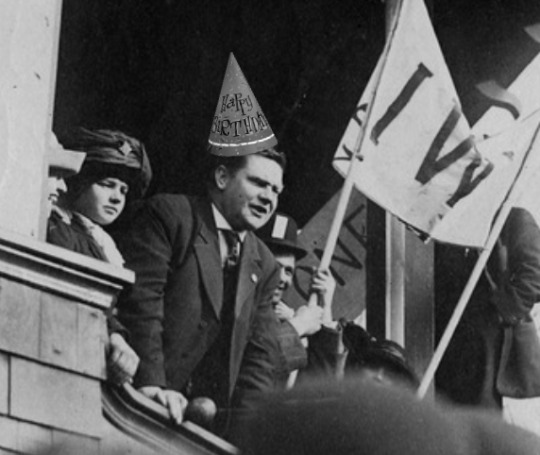
Happy birthday, Big Bill Haywood! (February 4, 1869)
A leader and organizer of the Industrial Workers of the World in its earliest years, Bill Haywood was born in Salt Lake City in the then-territory of Utah, and began working as a miner at age 15. He became involved in the emerging labor movement in his 20s, and joined the Western Federation of Miners in 1896. The WFM's defeat in the Colorado Labor Wars cemented Haywood's commitment to industrial unionism and the concept of One Big Union which would unite all workers in all industries, organizing the working class into a single unit which would be able to topple the capitalist system in one general strike. To this end, Haywood became a founder of the IWW and one of its most outspoken and articulate ideologues. Tremendously charismatic, Haywood won the respect and admiration of many American workers and helped to organize and lead a number of protests and strikes, including the Lawrence Textile Strike of 1912. At the height of the First Red Scare, Haywood fled the United States and took asylum in the Soviet Union, becoming a labor advisor to the new Bolshevik government. He died in 1928 of complications from diabetes.
"The capitalist has no heart, but harpoon him in the pocketbook and you will draw blood."
270 notes
·
View notes
Text
☄️ASTEROIDS
Part 1 • Copywriters Reserved©️GeminiMoonMadness

The asteroids show how you react to certain situations in your life, you could say they add shape to it. If you have strong aspects to an asteroid it’ll be more prominent in your life. Some asteroids will have minimal effect on you, depending on it’s placement in your birth chart.
ATE (111)-
It’s Assertiveness that's bordering on intolerance. When you respond OTT to a real or imagined threat. If ATE is afflicted with Squares or Oppositions there’s a chance you have issues letting your guard down. You may take things too seriously where you’re unable to take a joke.
BEER (1896)-
If prominent in your chart, it can indicate an issue controlling alcohol intake. Alcoholics usually have aspects such as;
BEER Square NN/SN
BEER Conjunct Moon
BEER Conjunct Jupiter
Any aspects to the asteroid ATE(111) -Trine especially
CLOELIA (661)-
If this asteroid is prominent in your chart you’re someone who has a fighting spirit with a strong sense of justice. Cloelia conjunct an angle (IC, MC, ASC, DSC) or personal planet can indicate an someone who is able to free themselves or others. This Asteroid can be seen as a response to hardship, for example; Cloelia conjunct IC, an individual may have the ability of freeing/liberating their family members from limiting ideas or practices that keep them in metaphorical captivity. This asteroid is prominent in charts of people who often speak up for those in trouble and advocating for causes close to their hearts.
ELPIS (59)-
If prominent in your chart it can indicate that you’re a positive, hopeful and expectant person with a consistent sense of desire. Due to this enduring desire, the individual is able to reach the goals they set easier then most. If Afflicted with squares and oppositions, a person may have a negative outlook on life. If Aspected with conjunctions, sextiles & trines, a person is able to successfully renew hope in their lives even after facing situations where most would lose faith.
FIDES (37)-
The asteroid of Truth, trust, faith and honestly. FIDES conjunct, sextile & trine personal planets makes a person Trustworthy, Honest, Dignified and hold moral integrity. This person is seen as truthful & fair by others. If afflicted with squares & oppositions, a person may have trust issues, be dishonest and seen as somewhat disrespectful.
NARCISSUS (37117)-
If Prominent in a chart it can indicate someone who is physically attractive but self absorbed, selfish, or simply thinks too ‘highly’ of themselves. If Afflicted with squares and oppositions, a person may have issues understanding other peoples point of view or sympathising with them. It overall indicates a narcissistic personality/NPD. For example: Narcissus conjunct North Node- Will become a narcissist in this life. 
PERSEVERANTIA (975)-
This asteroid is associated with the idea of never giving up and having the strength to persevere for the long haul. The sign & house your Perseverantia is in is the area of life you have perseverance, dedication, endurance & discipline. Example: If it's in Cancer/4th House- Dedication to Family, you’ll do anything for them. When not feeling yourself, they keep you going and the source of your strength. Capricorn/10th House dedication to your career and reputation. You will do virtually anything to get to the top, get rich and gain status.
THALIA (23)-
If Prominent in the chart it can indicate someone with a happy, bubbly, entertaining and funny personality. If you have thalia conjunct personal planets you may be known as the 'Class Clown'. You’d be someone who'd make a good Host. If afflicted with squares and oppositions it's not necessarily a bad thing! It just gives an individual a dark sense of humour, one that tends to shock others.
ASTROWIZARD (24626)-
Represents an entertaining yet educational outreach (especially to children). People with this asteroid prominent in their chart have a talent at educating and entertaining others at the same time. They have a fun instead of a boring personality, for example- Someone who has prominent aspects to the asteroid Astrowizard will dress up, sing, dance and be hands on to get their point across rather then use the average whiteboard approach. If prominent in your chart it can also show a deep interest in Astrology and Astronomy.
BELLONA (28)-
When prominent in a chart it indicates powerhouse type personality. Someone that isn't afraid to stand up for themselves or others, people who are be ready to 'battle and defend what they perceive is right. With mixed aspects a person can balance going over board at times and still have a healthy amount of assertiveness. Easy aspects like Trine or Sextile make a person seem to know how to be assertive when & where needed. They easily stand up for themselves and others they care for. Hard Aspects like Square & opposition can cause a person to have assertiveness that borders intolerance. These people take offence easily.
ELVIRA (277)-
This asteroid brings mournful qualities, a hopeless romantic, someone with a sedimental heart. If aspected with Squares and Oppositions, a person will be very dark and depressing to interact with. Prominent aspects will make someone a pessimist, having a cup have empty rather than cup half full outlook.
MELANCHOLIA (5708)-
This asteroid is associated with long term sadness and depression. Having square & opposition aspects will give a person depression, moments of sadness and mourning. Having trine &' sextile aspects seem to be able to cope with the events in life that trigger these emotions. Ability to Cope is more developed if easily aspected.
FELICIA (294)-
It’s our ability to maintain a happy disposition in life and a certain degree of luck. If Prominent in a chart, regardless of what they’ve been through they remain happy, bubbly, cheerful. If negatively aspected or not aspected at all individuals may have a hard time maintaining happiness throughout their life circumstances. TIP- If poorly aspected, Work on your mindset!
HARMONIA (40)-
If prominent in your chart you have more chance in succeeding in the Music Industy/Field. Having conjunct, sextile and trine aspects to this asteroid gives you a natural affinity for creating music that's pleasurable to the senses. If negatively aspected you may still have musical interest but not necessarily be good at it, for example: Someone who loves to sing along to the radio in the car. Hard work needs to be put in place if you want to succeed.
SOPHIA (251)-
This asteroid gives an above average sense of wisdom, insight and intuition that can surprise others. The house & Sign it's in can also show where you have wisdom, for example; Someone with Sophia conjunct Uranus may have natural wisdom when it comes to individuality, Standing out from the crowd and innovation. With Sophia Conjunct Neptune, Same may apply but to the matters of Spirituality, religion and the ego. When Aspected with trines & sextiles this wisdom is easily perceived by others as a gift. If aspected by squares & oppositions, others perceive your knowledge to come from a place of superiority or a bit of a know it all.
AGRIPPINA (645)-
If Prominent in a chart it can show someone is an opportunistic person who may take unorthodox actions to meet their goals. They have the ability to rise through the ranks of society or obtain power in ways others do not. If aspected with squares and oppositions an individual may be tempted to resort to deception and manipulation to obtain what they desire. If aspected with trines and sextiles an individual will stay on track, experience less resistance & pursue their goals with ease.
 ARMISTICIA (1464)-
If Prominent in a chart, someone can be given a natural talent as a peacekeeper or effective negotiator. The glue that holds family, friends and even co workers together can be seen with trine and sextile aspects. If poorly aspected, with squares and oppositions you'll see people who cut ties with those dear to them or have broken relations. These individuals hold grudges longer then most. If positively aspected, An individual will readily forgive others when hurt or harmed.
☄️✨
Let me know what you think of that! Do you have any of these asteroids prominent in your chart or know someone who does? Any asteroids you want to see in part 2?
#astro community#astrology observations#astrology#asteroid#asteroids astrology#Astro asteroids#astro posts#astro placements#astro aspects#astrology aspects#astrology placements#astro observations#astrology community#easy astrology#astrology placement#astrology posts#Astro post#astro notes#astrology note#astrotips#astro notes#astrology tips#asteroid narcissus#asteroids in the chart#asteroid observations#astrology notes#birth chart#astrology asteroids#astrology tag#astrology things
341 notes
·
View notes
Photo



Arthur Streeton - The River, New South Wales, 1896, Australia, oil on canvas; The Purple Noon's Transparent Might, Sydney, New South Wales; The Murray and the Mountain, 1930, oil on canvas
Sir Arthur Ernest Streeton (1867–1943) was a great Australian Impressionist landscape painter. He was born in Duneed, Victoria, Australia. Aged 15 years, he began night classes at the National Gallery of Victoria School of Design. He also learned the rudiments from studying art manuals and photographs.
At age nineteen, he began an apprenticeship as a lithographer. He also joined a painting group where he painted plein air, alongside Tom Roberts, Frederick McCubbin, and Louis Abrahams. He soon became a full time painter and developed a friendship with Charles Conder. The group of artists often camped and painted outdoors at Box Hill, Heidelberg, and the Yarra. They also provided art lessons and formed the Heidelberg School. During the 1890s, Streeton traveled further inland in New South Wales to explore the outback and the Hawkesbury River.
Streeton traveled to England. He took some time to adjust his artistic identity and become acquainted with very different landscapes. His best market was sending his English works for sale in Australia. Gradually, he began to win recognition in England, France, and the United States.
In 1915, Streeton served as a private in the Australian Army Medical Corps. After three years, he was appointed an official war artist and painted the Western Front in France. After the war, Streeton returned to painting romantic visions of the Australian landscape. By this time, he was a well-established painter. In 1937, was knighted for services to the arts.
#Arthur Streeton#Sir Arthur Ernest Streeton#New South Wales#river#Australian landscape#landscape#realism#oil painting#oil on canvas
174 notes
·
View notes
Text
Dobry wieczór. Since it’s International Women’s Day (albeit not strictly), tonight I would like to draw my followers’ attention to the female pianists and composers who were my contemporaries… Apologies for the lengthiness, evidently there is a lot to be covered.
Clara Schumann 1819-1896
youtube
A child prodigy, Clara was taught piano by her father and by thirteen he was taking her on concert tours.
She met Robert Schumann as a child when he came to Leipzig to study law at the university. He took piano lessons from Clara’s father, Friedrich Wieck. When she was 18, he proposed to her. They married in 1840.
The virtuoso went on tours with her husband and earn money by performing and teaching. She was also a gifted composer, however most of her time was spent looking after her family, editing Robert’s music and playing. Clara’s compositions include more than 20 piano works, a piano concerto, some chamber music and several songs.
Fanny Mendelssohn 1805–1847
youtube
Composer and pianist, Fanny grew up in Berlin, sharing the same musical education as her brother Felix, with whom she had a close relationship.
Her compositions include a piano trio, a piano quartet, an orchestral overture, four cantatas, more than 125 pieces for the piano and over 250 lieder, most of which were unpublished in her lifetime. Although lauded for her piano technique, she rarely gave public performances outside her family circle.
Owing to her family's reservations and to social conventions of the time about the roles of women, six of her songs were published under her brother's name in his Opus 8 and 9 collections.
Marie Moke 1811-1874
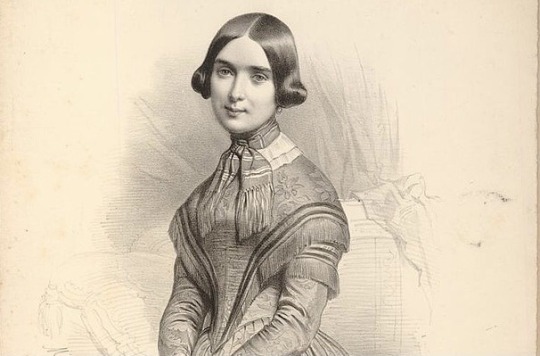
Marie Moke gave her first concert at the age of eight and by the age of fifteen, she was already known in Belgium, Austria, Germany and Russia as an accomplished virtuoso.
She married pianist and piano manufacturer, Camille Pleyel, but they later separated on account of her promiscuity. Heinrich Heine considered her among the greatest pianists “Thalberg is a king, Liszt a prophet, Chopin a poet, Herz an advocate, Kalkbrenner a minstrel, Mme Pleyel a sibyl, and Döhler a pianist.”
Later on, she created the piano school at the Royal Conservatory in Brussels where she taught from 1848 to 1872.
Louise Farrenc 1804-1875
youtube
A French composer, virtuoso pianist and teacher, she started playing young and had piano lessons with famous teachers such as Moscheles and Hummel. She studied composition privately with Anton Reicha at the Paris Conservatoire, unable to go to composition classes as a woman. By the 1820s she was touring France, giving concerts.
In 1842 she was made Professor of Piano at the Paris Conservatoire where she stayed for 30 years. For a decade she was paid less than the male teachers. Only after the triumphant premiere of her nonet did she demand and receive equal pay. She wrote a wide variety of piano music, but her chamber pieces are considered to be her best work.
Pauline Viardot 1821-1910
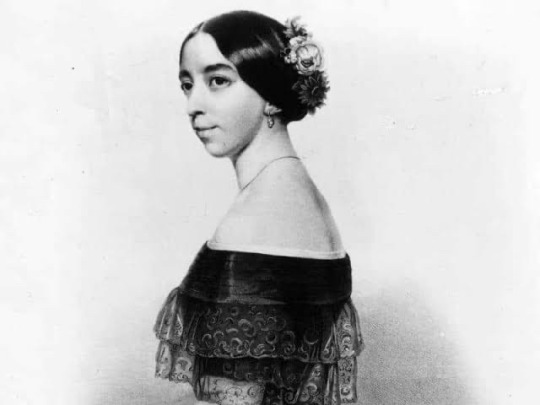
From a musical family (including her older sister, Maria Malibran) Pauline was trained by her father on the piano and in singing.
In her youth she took piano lessons with Franz Liszt and counterpoint and harmony classes with Anton Reicha. However, despite wanting to become a concert pianist, she was directed towards singing by her mother.
Pauline began composing when she was young, but it was never her intention to become a composer. Written mainly as private pieces for her students, her works were still of professional quality and Franz Liszt declared that, with Pauline Viardot, the world had finally found a woman composer of genius. Compositions include her chamber operas Le dernier sorcier and Cendrillon.
Arabella Goddard 1836–1922
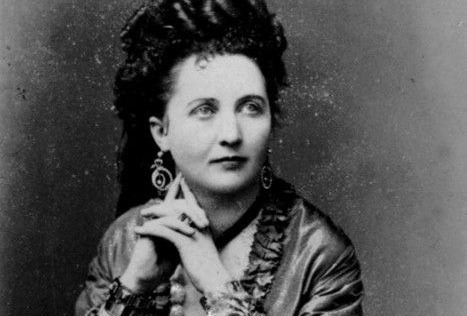
Born in France to English parents, at age six Arabella was sent to Paris to study with Friedrich Kalkbrenner. Aged seven she played for myself and George much to our pleasure.
During the 1848 Revolution her family had to return to England; there, Arabella had further lessons with Lucy Anderson and Sigismond Thalberg. She was known for her ability to play recitals from memory.
Arabella was appointed a teacher at the Royal College of Music in 1883. This was the RCM’s first year of operation and Arabella was its first female professor. She composed a small number of piano pieces, including a suite of six waltzes.
Marcelina Czartoryska 1817-1894

Born into the aristocratic Polish family, the Radziwiłłs, Marcelina was taught piano by Carl Czerny in Vienna and by myself in Paris. She gave concerts across Europe, with Franz Liszt, Pauline Viardot and Henri Vieuxtemps.
From 1870 she lived in Kraków, where she gave mainly private concerts and, thanks to her artistic connections, contributed to founding Kraków’s Academy of Music in 1888.
Maria Kalergis 1822-1874

Raised in Saint Petersburg in the home of her paternal uncle, the Tsar's minister of foreign affairs, Maria received a thorough education where she evinced an early musical talent.
She was a student of mine and held salons in Paris whose guests included Liszt, Richard Wagner, de Musset, Gautier and Heine. Later, she became a hostess and a patron of the arts in Warsaw.
She was a co-founder of the Warsaw Musical Institute, now the Warsaw Conservatory and established the Warsaw Musical Society, now the Warsaw Philharmonic. Between 1857 and 1871 she made frequent appearances as a pianist.
On her death, Franz Liszt wrote his Elegy on Marie Kalergi.
#clara schumann#fanny mendelssohn#classical composers#romantic era#classical music#international women's day
28 notes
·
View notes
Text

Florence Carlyle - The Guest, Venice (1913)
Florence Carlyle (1864-1923) was a Canadian painter born in Ontario. Carlyle studied painting in Paris beginning in 1890, where she exhibited work at Paris Salons while gaining recognition in Canada and the United States – achievements unusual for women of her time. After Carlyle returned to Canada in 1896, she continued to exhibit widely and contributed artworks to major exhibitions and museum collections. Influenced by the French Barbizon School, Impressionism, and the work of fellow female painters, Carlyle was known for intimate, domestic scenes of middle-class women’s lives.
In 1911, Carlyle traveled to Italy and England, where she met Judith Hastings, who would become her lifelong companion and model. In 1913, Carlyle and Hastings settled in Yew Tree Cottage in East Sussex. The Guest, Venice shows Hastings and Carlyle in conversation at sunset in a scene dominated by warm reds and yellows. The women’s poses and gestures seem to reflect each other – Hastings, seated, invitingly pulls on a long necklace while Carlyle leans comfortably on a windowsill, their complimentary poses suggesting an intimate relationship. (source)
54 notes
·
View notes